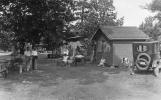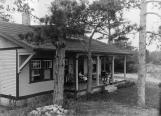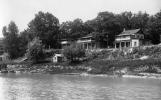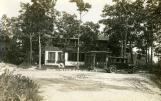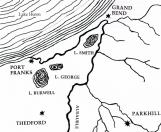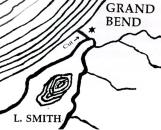2
Spring Cleaning1930's
Grand Bend, Ontario
The task of opening up and cleaning the cottage was all important. We used to string wire clothes lines between the pine trees to air the bedding and curtains; we put the mattresses out in the sun; cleaned out mice-nests from cupboard drawers - once flying squirrels had wintered in the cottage and really made a mess of things - scrubbed the floor with hot water and Sunlight soap (no fancy detergents in those days) and soon had the cottage smelling fresh and inviting after the mustiness had gone out with the cobwebs.
Certainly our own cottage was nothing much to boast about. "The Oaks", as it was called, was a roughly-built, frame bungalow, redeemed only by a wide verandah on two sides. Inside, partitions and curtains hung on wires with curtain-rings formed three small bedrooms. Mother later had carpenters make a corner cupboard and washroom combined.
The verandah at first was completely open, but father had it boarded up part way and the upper part enclosed in wire-screening. The cottage had no city conveniences - no running water, flush toilet or electricity. We had coal-oil lamps, a four-burner Perfection coal-oil stove (replacing the original wood stove) an ice-box, and, of course, an outside privy furnished with a box of sand, a bucket of lime, and an old T. Eaton Co. catalogue (for use in emergencies if toilet paper ran out). From the cottage, which was set well back in the woods, there was no view of the lake, but we were protected from the gales by the sand dunes of the beach, where we could go to watch the sunsets only a stone's throw away.
Credits:H Pearson Gundy
8
Recollections of Grand Bend by H. Pearson Gundy1925
Grand Bend, Ontario
Shortly after the turn of the century and two or three years before I was born, my father bought a small cottage at Grand Bend on Lake Huron. This was to be the family summer home for over a quarter of a century. The Bend, as it was familiarly called, took its name from a sharp bend in the meandering Aux Sables River about a quarter of a mile from the lake into which it was prevented from emptying at this point by a series of sand dunes.
A decade or so before we went to Grand Bend, however, man had sought to improve upon Nature by cutting a channel to the lake through the obstructing dunes, thus leaving the old river bed a mere trickle of water fed by spring freshets and summer rains. A long pier and breakwater prevented the cut from silting up and provided a safe harbour for fishermen who worked seine nets about a mile out from shore.
Credits:H. Pearson Gundy
10
French-Canadian Families arrive1925
Grand Bend, Ontario
The small English-Canadian settlement at Brewster's Mill, as the Bend was first called, was augmented in the middle years of the last century by several French-Canadian families of Huguenot stock - Desjardins, Ravelle, Charreau and others - from the St. Francis River district north of Sherbrooke, Quebec. Before long they numbered upwards of 100, and though they retained their native tongue in their homes, they became fully integrated into the English-speaking community where their names were corrupted in pronunciation and even spelling to "Disherdaw, Revell, and Sharrow."
Credits:H Pearson Gundy
12
Rev. Carrière1925
Grand Bend, Ontario
In the 1870's when Rev. Dr. Charles Chiniquy, ex-Roman Catholic priest turned Presbyterian, was placed in charge of all French-Canadian Presbyterian missions, he sent a young compatriot to minister to the small settlement at Grand Bend. When we first went to the Bend, Rev. Carrière was a sturdy, white-haired man of florid complexion and benevolent aspect, greatly beloved by all his flock, French and English alike.
Church services were conducted in English and also in French, although by that time the descendants of the original settlers from Quebec were even more fluent in English than in French. But not so Rev. Carrière who was eloquent in his mother tongue but spoke English more slowly and with a French accent which occasionally tripped him up. I well remember how disconcerted he was when, after announcing that the subject of his sermon was "Moses in the Dessert", he was assailed by fits of laughter.
Credits:H. Pearson Gundy
14
Swimming and sunbathing1925
Grand Bend, Ontario
Swimming and sunbathing were ideal at Grand Bend with its long expanse of pure white sandy beach. We used to make huge rafts of logs thrown up by storms and at the end of our swim pull them well up on the beach. A sand bar a hundred feet or so from the shore helped to moderate the temperature of the water and made swimming relatively safe. In storms the breakers came in long combers which would carry us from the sand bar to the shore, but we had to beware the undertow which was very strong. I well remember the shock of seeing a victim of the undertow dragged ashore by friends and the vain attempts made to revive him by artificial respiration. When a doctor arrived he pronounced him dead.
In a heavy gale it was almost impossible to stay on the beach as the wind whipped up the sand with a stinging force. We used to go down to the pier by the river, however, and watch the breakers dash against it with incredible force. Sometimes a good deal of damage was done, but it was immediately repaired when the storm was over.
Credits:H. Pearson Gundy

